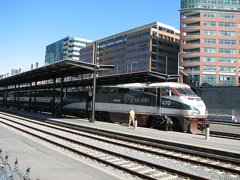
The Washington State Department of Transportation is preparing to spend more than $700 million upgrading the century-old railway that links Portland, Seattle and Vancouver.
The funds could flow as soon as this fall, as part of President Barack Obama's $8 billion plan to stimulate the U.S. economy by pouring money into shovel-ready improvements to that nation's passenger rail lines.
But Washington State does not plan to spend a single penny of that windfall improving tracks north of Seattle. Rather, it will all be poured into the Seattle-to-Portland section.
Why? Because for more than a decade, Washington State has been dribbling its own money into rebuilding the international railway, while urging British Columbia to do the same. And for just as long, the government of B.C. has been blowing off the American overtures.
Obama throws open the throttle
As The Tyee reported yesterday, Washington State has spent the past 18 years laying plans to incrementally improve rail service from Eugene, Oregon, to Vancouver, British Columbia.
The 750-kilometer route was designated as a "high speed rail corridor" in 1992, in preparation for federal funds that were expected to flow after the election of U.S. President Bill Clinton. But Republicans took control of the U.S. Congress two years later, and choked passenger rail for the next decade and a half.
U.S. President Barack Obama revived American rail last month with the announcement of an $8 billion "down payment" on passenger rail improvements, along with $1 billion a year for the next five years and the promise of more to follow.
In order to get that $8 billion stimulus pumping through the veins of the American economy as quickly as possible, the Obama administration put relatively simple rules on how that money can be spent. Basically, it must be used for shovel-ready construction (as opposed to planning) along existing high-speed rail corridors (as opposed to new routes).
The announcement was a boon for the Washington State Department of Transportation, which had spent the past decade not only planning passenger rail projects, but also shepherding them through slow-moving environmental review processes.
"We've got several projects we can put forward to go after that money," State Rail and Marine Office spokesperson Vicki Sheehan told The Tyee.
Sheehan said Washington State would be requesting "more than $700 million" worth of rail stimulus money.
"We've still got another project or two we're trying to get on the list," she added. "This is more than the U.S. has ever previously invested in passenger rail."
B.C. 'contributed little or no funds'
About one-quarter of the Seattle-to-Vancouver line is located in British Columbia. Most of that right-of-way is more than a century old. As a result, even 21st century trains must slow to 19th century speeds of 10 miles per hour when crossing the antique Fraser River Swing Bridge, and 15 miles per hour while snaking through White Rock.
In 2006, the Washington State Department of Transportation published a long-range plan for Amtrak Cascades inter-city passenger rail that included a detailed list of improvements British Columbia would need to undertake in order to cut the travel time to Seattle from the excruciating four hours it takes today to a more respectable speed of two-and-a-half hours -- which is about what it takes to drive.
The list suggested by Washington State included several new sidings in Burnaby and Delta, higher-speed tracks in White Rock, a new traffic control system and one big-ticket item: a new rail bridge across the Fraser River. Altogether, Washington figured these improvements would cost about a billion dollars -- with the new bridge eating up more than half of that total.
The 2006 report noted that Washington and Oregon had already committed to more than $800 million dollars worth of such expenditures, while British Columbia had spent nothing.
"Without implementation of these projects, the build-out of the passenger rail program will not be achieved," the 2006 plan stated.
"The lack of detailed plans for the segments outside of Washington could result in the inability to continue Amtrak Cascades program development in Washington," the plan warned.
An unofficial paper co-authored by three top project managers within the Washington State rail office was more blunt.
"...the Province of British Columbia [has] contributed little or no funds toward the current service," stated the 2007 paper, entitled, "Pacific Northwest Rail Corridor -- Building Blocks Into the Future."
By 2008, when the state transportation department released a follow-up planning document, all mention of British Columbia's participation has been erased from the plan. It was as if Washington State had simply given up on the Vancouver run.
'Funding is probably a key element'
Transportation Minister Kevin Falcon refused The Tyee's request to be interviewed for this article.
The B.C. Transportation Plan includes no mention of the Cascades project or the required track improvements. Likewise, B.C.'s "major projects inventory," a list of foreseen provincial expenditures, has since 2001 carried forward only a vague note earmarking $20 million for unspecified Amtrak rail improvements.
Washington State rail office spokesperson Vicki Sheehan would not comment on why Washington was investing nothing in the northern route, except to politely direct The Tyee's attention to these reports.
"We've faced considerable difficulty in getting even a second train rolling to B.C.," Sheehan said.
She did note that as prior investments have improved service on the southern route, Vancouver has fallen from the third most popular destination on the Cascades line (behind Seattle and Portland) to fifth place (behind Eugene). She said that about 668,000 passengers stepped on or off the train in Seattle last year, and about 660,000 in Portland. Only 115,000 did so in Vancouver.
Federal Railroad Administration spokesman Warren Flatau was more direct.
"I don't think Washington State is going to seek funding for that [Vancouver route] unless they know that there is a strong partner on the other side of the border," Flateau said.
The Tyee asked Flateau, who works in the U.S. Department of Transportation's offices in Washington D.C., what American officials would need to see in order change their minds about Canada in general and British Columbia in particular.
"What we would expect to hear from Canadian governments at the federal and provincial level -- as well as at the local and regional levels, for that matter -- would be explicit statements of support for developing some type of rail connection," Flateau said.
What form might such statements take?
"Funding is probably a key element," he replied. "An expressed willingness that the government, presumably at the federal level, is prepared to commit resources to make it happen."
Tomorrow: How Ottawa has barred a second daily Amtrak train from crossing the border.
Related Tyee stories:
- The Myth of High-Speed Rail for BC
No key player -- not Obama, Harper, Campbell or Washington State -- is on board with high-speed rail to Vancouver. Part one of four. - The Dangerous Lives of Train-hopping 'Yohos'
Illegal and risky, it's an adventure for some kids. - On Track for Another Toxic Rail Derailment?
'Safest' train company in North America still threatens salmon, people.
Read more: Politics, Transportation
















Tyee Commenting Guidelines
Comments that violate guidelines risk being deleted, and violations may result in a temporary or permanent user ban. Maintain the spirit of good conversation to stay in the discussion.
*Please note The Tyee is not a forum for spreading misinformation about COVID-19, denying its existence or minimizing its risk to public health.
Do:
Do not: